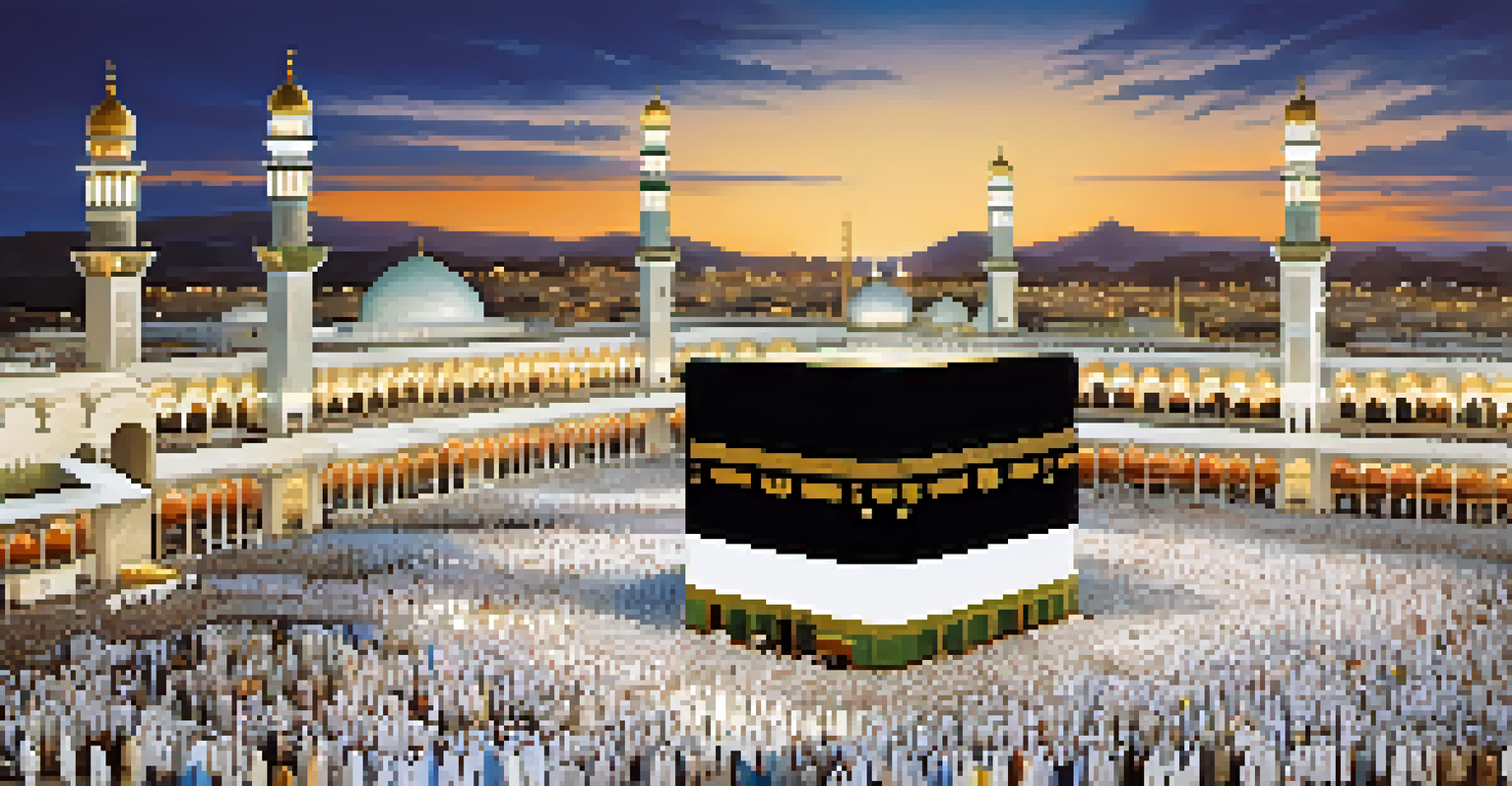Cultural Significance of Pilgrimages in Modern Society

Understanding Pilgrimages: A Historical Overview
Pilgrimages have been a part of human culture for centuries, serving as profound journeys to sacred sites. Historically, they were often religious in nature, allowing individuals to seek spiritual enlightenment or fulfill vows. Over time, these journeys evolved, incorporating cultural, social, and personal dimensions that resonate with modern society. Today, the essence of pilgrimage transcends religious boundaries, embracing various motivations that reflect the diverse experiences of individuals.
A pilgrimage is a journey of the heart, an exploration of the self, and a quest for meaning and connection.
For example, the Camino de Santiago in Spain has seen an influx of not only religious pilgrims but also those seeking personal growth or adventure. This shift highlights how the act of pilgrimage can serve different purposes in contemporary life, making it more accessible to a broader audience. Furthermore, the increasing interest in mindfulness and self-discovery has led many to embark on these journeys not just for spiritual reasons, but also for introspection.
In essence, understanding the historical significance of pilgrimages enriches our appreciation of their current relevance. As we explore this topic further, we'll uncover how these journeys continue to shape identities, foster connections, and influence cultures around the world.
Modern Motivations: Why People Embark on Pilgrimages Today
While traditional pilgrimages were often rooted in faith, today's motivations are incredibly diverse. Many individuals now seek out these journeys for personal transformation, adventure, or a break from the hustle and bustle of daily life. For instance, some travelers embark on pilgrimages as a means to escape technology and reconnect with nature, finding solace in the simplicity of the journey.

Additionally, pilgrimages can serve as a way to process grief or significant life changes. For example, someone dealing with loss might find comfort in traversing a path taken by those who have faced similar struggles. This emotional aspect adds depth to the pilgrimage experience, allowing individuals to find meaning and healing along their journey.
Pilgrimages Reflect Modern Journeys
Today's pilgrimages encompass personal transformation, adventure, and healing, moving beyond traditional religious motivations.
Ultimately, the motivations behind modern pilgrimages reflect a broader societal shift toward seeking authenticity and connection. As we continue to explore this topic, we will see how these motivations intertwine with cultural practices and personal narratives.
Cultural Exchange: Pilgrimages as a Bridge Between Communities
Pilgrimages often bring together people from various backgrounds, creating a unique opportunity for cultural exchange. As individuals walk the same paths, they share stories, traditions, and experiences, fostering connections that transcend borders. For instance, the Hajj pilgrimage in Mecca attracts millions of Muslims from around the globe, each contributing their own cultural nuances to the collective experience.
The journey itself is my home.
This blending of cultures enriches the pilgrimage experience, allowing participants to gain a deeper understanding of different perspectives and practices. Such interactions can challenge stereotypes and promote tolerance, as pilgrims bond over their shared journey. The result is a tapestry of human experience woven together through the threads of faith, culture, and personal stories.
As we examine the cultural significance of pilgrimages, it becomes clear that they serve as vital bridges between communities, fostering unity in diversity. The importance of these interactions cannot be understated, as they play a crucial role in shaping a more interconnected world.
The Role of Technology in Modern Pilgrimages
In an age dominated by technology, the experience of pilgrimage has been transformed in various ways. Social media, for example, allows pilgrims to document and share their journeys instantly, creating a sense of community among those who may never meet in person. This digital connection can enhance the pilgrimage experience, as individuals feel supported by a larger audience cheering them on from afar.
However, this reliance on technology also raises questions about the authenticity of the pilgrimage experience. Some argue that constant connectivity detracts from the introspective nature of these journeys, making it difficult to disconnect and fully engage with the surroundings. Balancing the benefits of technology with the need for genuine experience is an ongoing challenge for many modern pilgrims.
Cultural Exchange Through Pilgrimages
Pilgrimages foster connections between diverse communities, promoting understanding and tolerance through shared experiences.
As we explore the impact of technology on pilgrimages, it becomes evident that it can both enrich and complicate the journey. Understanding this dynamic is essential for appreciating how modern pilgrims navigate their paths in a digitally connected world.
Pilgrimages and Mental Health: A Journey to Wellness
Increasingly, researchers are recognizing the mental health benefits of undertaking a pilgrimage. The act of walking long distances, often in serene environments, can serve as a form of moving meditation, helping individuals clear their minds and focus on the present. This has led many to find solace and comfort on their journeys, allowing them to grapple with life’s challenges in a supportive environment.
For instance, some studies suggest that participants in pilgrimage routes report lower levels of anxiety and depression after their journeys compared to before. This phenomenon can be attributed to the combination of physical activity, spiritual reflection, and community support that are integral to the pilgrimage experience. Such findings have sparked interest in promoting pilgrimages as a complementary approach to mental health treatment.
In essence, recognizing the mental health benefits of pilgrimages opens up new avenues for understanding their significance in modern society. As we continue to explore this topic, we will delve deeper into the relationship between these journeys and personal well-being.
The Environmental Impact of Pilgrimages
As the popularity of pilgrimages grows, so too does the need to consider their environmental impact. Many pilgrimage routes traverse pristine natural landscapes, raising concerns about the sustainability of these paths as foot traffic increases. Responsible pilgrimage practices, such as Leave No Trace principles, are crucial to preserving these environments for future generations while still allowing people to connect with nature.
Communities along pilgrimage routes also feel the effects of increased tourism, both positive and negative. While local economies can benefit from the influx of pilgrims, there can also be challenges related to overcrowding and resource management. Striking a balance between welcoming visitors and protecting the environment is essential for the sustainability of pilgrimage routes.
Mental Health Benefits of Pilgrimages
Walking long distances on pilgrimage routes offers mental wellness benefits, serving as a form of moving meditation that aids in emotional healing.
As we reflect on the environmental aspects of modern pilgrimages, it becomes clear that mindfulness in our travels is more important than ever. Understanding our impact and taking steps to minimize it can ensure that these sacred journeys remain accessible for years to come.
Conclusion: The Enduring Legacy of Pilgrimages
In conclusion, the cultural significance of pilgrimages in modern society is profound and multifaceted. These journeys continue to evolve, reflecting the diverse motivations and experiences of those who undertake them. From fostering cultural exchange to promoting mental health and environmental awareness, pilgrimages play a vital role in shaping our understanding of community, identity, and spirituality.
As we’ve explored, the essence of pilgrimage transcends traditional boundaries, inviting individuals from all walks of life to connect with themselves and others. The lessons learned along these journeys can resonate deeply, sparking personal growth and a greater understanding of the world around us.

Ultimately, the enduring legacy of pilgrimages is a testament to humanity's quest for meaning, connection, and understanding. As we embrace the modern pilgrimage experience, we honor the past while paving the way for future generations to embark on their own transformative journeys.